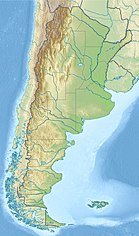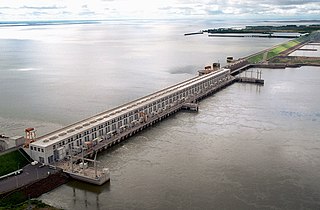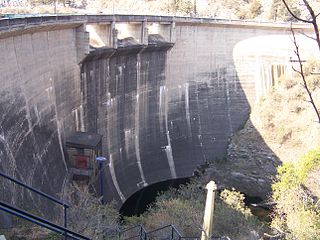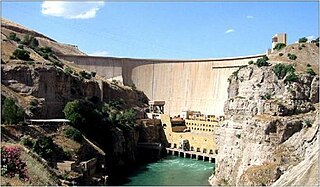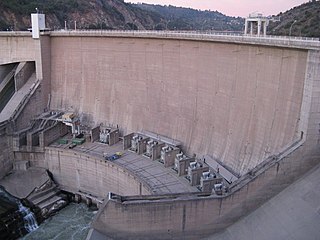| Pichi Picún Leufú Dam | |
|---|---|
| Country | Argentina |
| Location | Patagonia |
| Coordinates | 40°00′42″S69°59′27″W / 40.011592°S 69.990849°W Coordinates: 40°00′42″S69°59′27″W / 40.011592°S 69.990849°W |
| Status | Operational |
| Dam and spillways | |
| Type of dam | Embankment dam |
| Impounds | Limay River |
| Height | 45 m (148 ft) |
| Length | 1,045 m (3,428 ft) |
| Dam volume | 1,562,000 m3 (55,200,000 cu ft) |
| Reservoir | |
| Total capacity | 197×106 m3 (160,000 acre⋅ft) |
| Surface area | 19 km2 (7.3 sq mi) |
| Power Station | |
| Installed capacity | 261 MW (350,000 hp) |
The Pichi Picún Leufú Dam (in Spanish Embalse Pichi Picún Leufú) is the third of five dams on the Limay River in northwestern Argentine Patagonia (the Comahue region), near the town of Piedra del Águila.

A dam is a barrier that stops or restricts the flow of water or underground streams. Reservoirs created by dams not only suppress floods but also provide water for activities such as irrigation, human consumption, industrial use, aquaculture, and navigability. Hydropower is often used in conjunction with dams to generate electricity. A dam can also be used to collect water or for storage of water which can be evenly distributed between locations. Dams generally serve the primary purpose of retaining water, while other structures such as floodgates or levees are used to manage or prevent water flow into specific land regions. The earliest known dam is the Jawa Dam in Jordan, dating to 3,000 BC.

The Limay River is an important river in the northwestern Argentine Patagonia. It is born at the eastern end of the Nahuel Huapi Lake and flows in a meandering path for about 380 kilometres (240 mi), collecting the waters of several tributaries, such as the Traful River, the Pichileufú and the Collón Curá. It then meets the Neuquén River and together they become the Río Negro. At this confluence lies the city of Neuquén.

Argentina, officially the Argentine Republic, is a country located mostly in the southern half of South America. Sharing the bulk of the Southern Cone with Chile to the west, the country is also bordered by Bolivia and Paraguay to the north, Brazil to the northeast, Uruguay and the South Atlantic Ocean to the east, and the Drake Passage to the south. With a mainland area of 2,780,400 km2 (1,073,500 sq mi), Argentina is the eighth-largest country in the world, the fourth largest in the Americas, and the largest Spanish-speaking nation. The sovereign state is subdivided into twenty-three provinces and one autonomous city, Buenos Aires, which is the federal capital of the nation as decided by Congress. The provinces and the capital have their own constitutions, but exist under a federal system. Argentina claims sovereignty over part of Antarctica, the Falkland Islands, and South Georgia and the South Sandwich Islands.
The dam is used for the generation of hydroelectricity and for the regulation of the flow. It measures 45 metres (148 ft) in height and 1,045 metres (3,428 ft) in length, and is made of 1,562 million cubic metres (55.2×109 cu ft) of loose materials. It was built by the Sweden-based multinational Skanska, and inaugurated in 2000.

Hydroelectricity is electricity produced from hydropower. In 2015, hydropower generated 16.6% of the world's total electricity and 70% of all renewable electricity, and was expected to increase about 3.1% each year for the next 25 years.
Skanska AB is a multinational construction and development company based in Sweden. Skanska is the fifth largest construction company in the world according to Construction Global magazine. Notable Skanska projects include the World Trade Center Transportation Hub project, 30 St Mary Axe, MetLife Stadium, Mater Dei Hospital, among others.
The reservoir has an area of 19 square kilometres (7.3 sq mi) and a volume of 197 million cubic metres (160,000 acre⋅ft) in maximum normal conditions.
The hydroelectric plant has an installed power of 261 megawatts (350,000 hp) and generates an annual average of 1,080 gigawatt-hours (3,900 TJ). It employs three vertical-axis Kaplan turbines.

The Kaplan turbine is a propeller-type water turbine which has adjustable blades. It was developed in 1913 by Austrian professor Viktor Kaplan, who combined automatically adjusted propeller blades with automatically adjusted wicket gates to achieve efficiency over a wide range of flow and water level.
